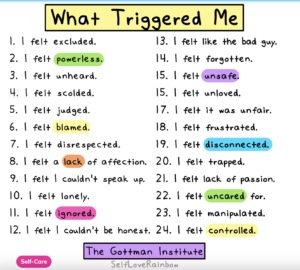 When someone’s behavior, words, or reaction in the present moment remind us of a painful experience in our past, we may have an exaggerated reaction. We are triggered.
When someone’s behavior, words, or reaction in the present moment remind us of a painful experience in our past, we may have an exaggerated reaction. We are triggered.
The amygdala, which detects threats and controls emotional reactions, becomes activated.
Hormones like cortisol and adrenaline are released, preparing the body for “fight, flight, freeze or fawn.”
Our reactivity is automatic and unconscious: it may be to
- FLEE (detach, dismiss and minimize),
- FREEZE (become anxious and fix),
- FIGHT (become angry and defensive), or
- FAWN.
“Fawning” is a fear response. The brain decides to try and please whoever is triggering the fear response in us to prevent them from causing harm.
This response is common in people who have been emotionally, physically or sexually abused, because they might try to avoid abuse by keeping the abuser as happy as possible.
Whether quiet or loud, our inward reactivity is intense because the feelings we had as a child flood our system in the present moment.
We are often unaware that we are experiencing a past experience/trauma in the current interaction.
In the face of a trigger, we are less able to communicate, problem solve, think logically or stay engaged in any constructive way. We often feel childlike because we are re-experiencing a childhood wound that activates the same past feelings and responses.
Sometimes, the wound has never been acknowledged, addressed or resolved.
That’s why it is so important not to take things personally.
Self-awareness, and acknowledging the triggers, is the door to the healing journey. We need someone who listens, validates and comforts us about those painful memories.
Understanding triggers can also help us have compassion for ourselves and others when we realize childhood wounds are at the root of frustration, irritation and reactive behavior.
What are your triggers? How are you working with them? Share your comments below. I would love to read them!
Leave a Reply